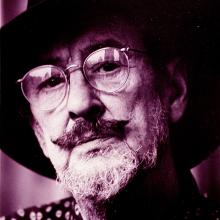
An exhibition at Whitespace Gallery this month looks at the work of Edinburgh-based Sax Shaw, a leading light amongst Scottish artists of the 20th century.
Shaw's career encompassed watercolour painting, tapestry and stained glass as his predominant media. However, he also turned his hand to theatrical design, church furnishings and vestsments, murals, mosaics and other decorative arts.
His paintings and tapestries have entered many collections, both private and public. His stained glass can be found in numerous Scottish churches, and is featured in the recently redesigned National Museum of Scotland on Chambers Street. Work finished by Shaw during his tenure as director of weaving there is currently displayed in the Dovecot Studio’s 'Weaving the Century' Exhibition.
Below, the artist's son Kevan Shaw – who has curated the retrospective at Whitespace in an effort to convey the depth and breadth of Shaw's work – gives a brief biographical account of his father's life, which included a long and creative sojourn in Edinburgh's New Town.
Sax Roland Shaw was born in the village of Berry Brow, Yorkshire in 1916, the forename reflecting his mother's admiration of the Edwardian novelist Sax Rohmer.
After leaving school he studied at Huddersfield School of Art between 1936 and 1938. Although offered a place at the Royal College of Art in London, he instead chose to study at Edinburgh College of Art (ECA), which at the time had the leading stained glass department in Great Britain. He met fellow art student Maisie Mallinson there. They were married in 1951.
Sax graduated in 1940. A pacifist, he became a conscientious objector and as an alternative to military service he was made to do farm labour in the Borders where he learned to drive tractors. There are very few pieces of work dating from the war years.
After the war, Sax returned to the ECA as a postgraduate while also working on independent projects, including some theatre design where he collaborated with Maisie to produce costumes, masks and sets for ballet.
In 1947 and 1948 he travelled to Paris on scholarships awarded by the College, and talked his way into the famous Gobelin tapestry studios where he was freely taught about their weaving techniques and design processes.
[img_assist|nid=3333|title='Liverpool'|desc=|link=node|align=middle|width=640|height=250]
During this period he and Maisie were living in Raeburn Place and Sax rented a small studio in Causewayside, where he began to produce both tapestry and stained glass. His growing reputation brought commissions from – among others – the Bute family, whose members had established the Dovecot Studios to create fabric designs of their stately home at Mount Stewart. This was the start of a relationship which continued through to the end of his working life.
This relationship led to Sax’s appointment as Director of Weaving at Dovecot Studios in 1953. Here he championed the role of the weaver as designer and artist, radically changing the techniques of weaving and establishing a style and practice that became synonymous with the Dovecot for the following 30 years.
Sax was a born teacher. At ECA he was a lecturer in Architecture and Interior Design, and also taught Stained Glass from 1948 to 1981. In addition he held visiting lectureships at Glasgow School of Art and the University of Edinburgh.
A polymath of the fine arts, Sax took commissions for mural painting, graphic design, mosaics, and church furnishings and vestments. Though each of these commissions produced work distinctive to the materials used, there is still evidence of motifs linking the various strands.
[img_assist|nid=3331|title='Marseille Boat' (1949)|desc=|link=node|align=right|width=640|height=437]The late 1960s saw significant changes to Sax’s work. Family holidays in France became pilgrimages to Arles and the Camargue (via many French cathedrals) to study and photograph the stained glass. During these trips Sax returned to painting watercolours as he had done during visits in the late 1940s.
The Camargue became a significant theme and inspiration throughout the 1970s and 1980s, as did the sunflowers which were in full bloom during the long drives through France.
Sax moved on from the Architecture Department at ECA to focus on teaching stained glass. During a very rich period he taught many of today’s leading practitioners including Liefur Breidfjord, who was later commissioned to make the West Window for St Giles Cathedral on the Royal Mile.
The 1970s and 1980s saw Sax at his most prolific in stained glass work, with bustling activity in his one-room studio which had been set aside for this purpose in the Howe Street family home since 1954. His son Christian worked with him, developing related work restoring many Victorian and Edwardian windows. The old techniques of glass staining and etching were fed back into designs for new windows created during this period.
Influenced by the visits to the Camargue, Sax learned Flamenco guitar and this music created a soundtrack to this period. In addition to the glass and tapestry designs, Sax began to explore a freer use of watercolour, moving away from his representational style to more expressive and sometimes quite emotional pieces.
[img_assist|nid=3334|title='Carmargue Panel'|desc=|link=node|align=middle|width=640|height=418]
After retiring from teaching in 1982 the work pace slowed. However, he remained active, completing commissions into the early 1990s, including a final window for the Marquis of Bute in the Chapel Crypt at Mount Stuart.
Sax Shaw died at his Howe Street home in September 2000, and is survived by two sons and wife Maisie (pictured below with part of the collection).
[The Sax Shaw Memorial Exhibition will run at Whitespace, 11 Gayfield Square, until 30 September 2012. For more on Sax Shaw, including the Ninian Dunnet obituary from which this article's title is drawn, visit: http://saxshaw.com]
[img_assist|nid=3332|title=|desc=|link=node|align=middle|width=640|height=482]